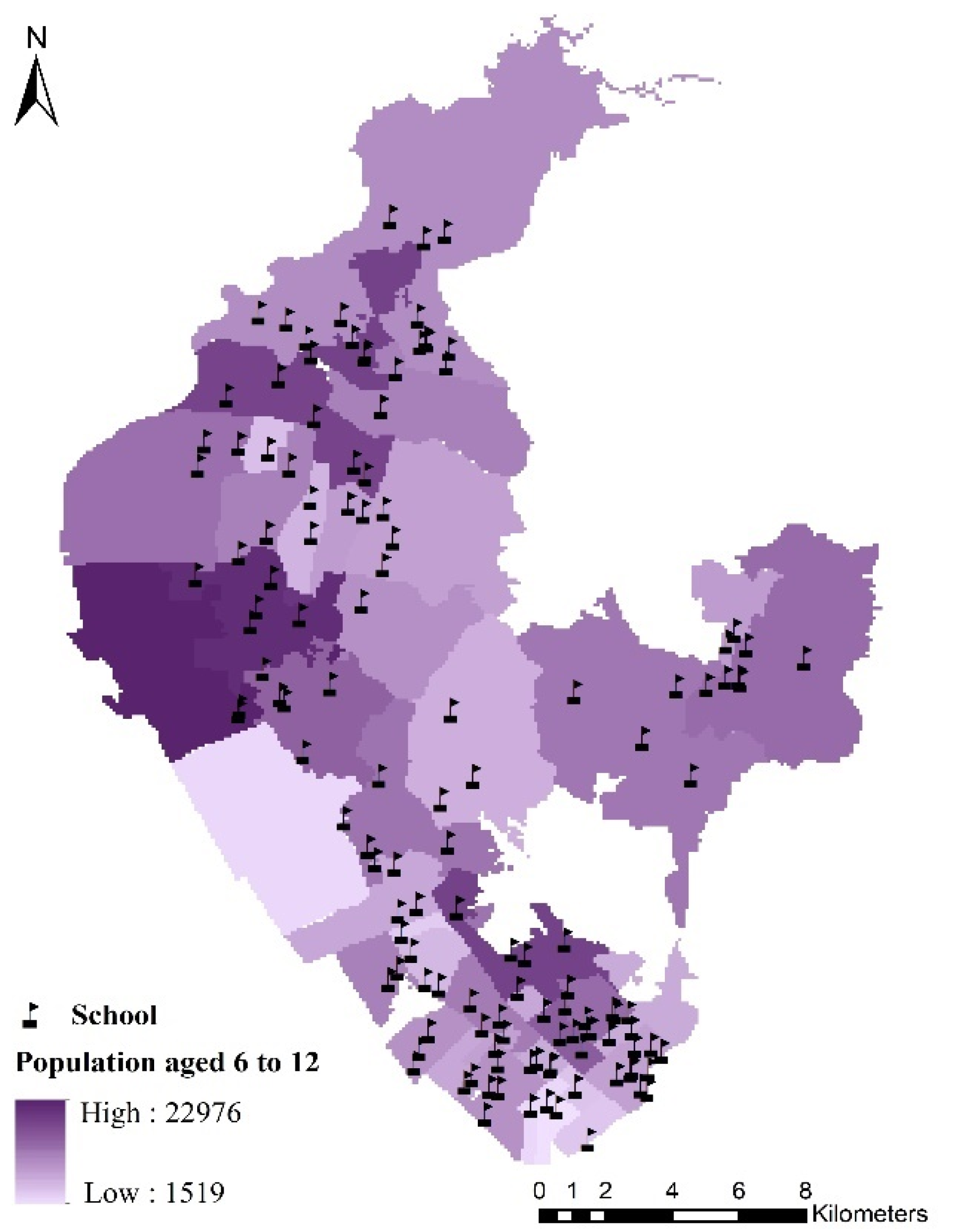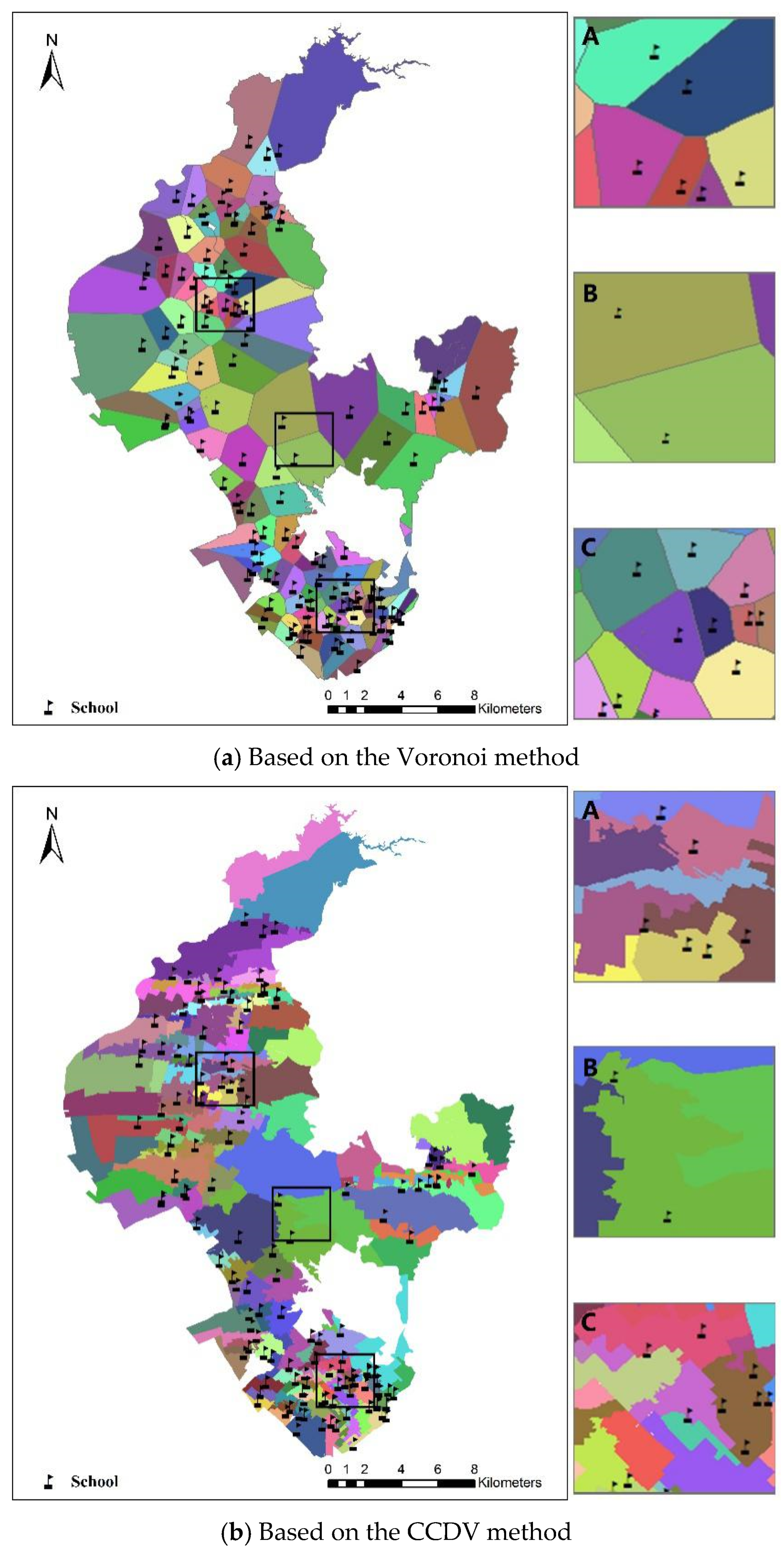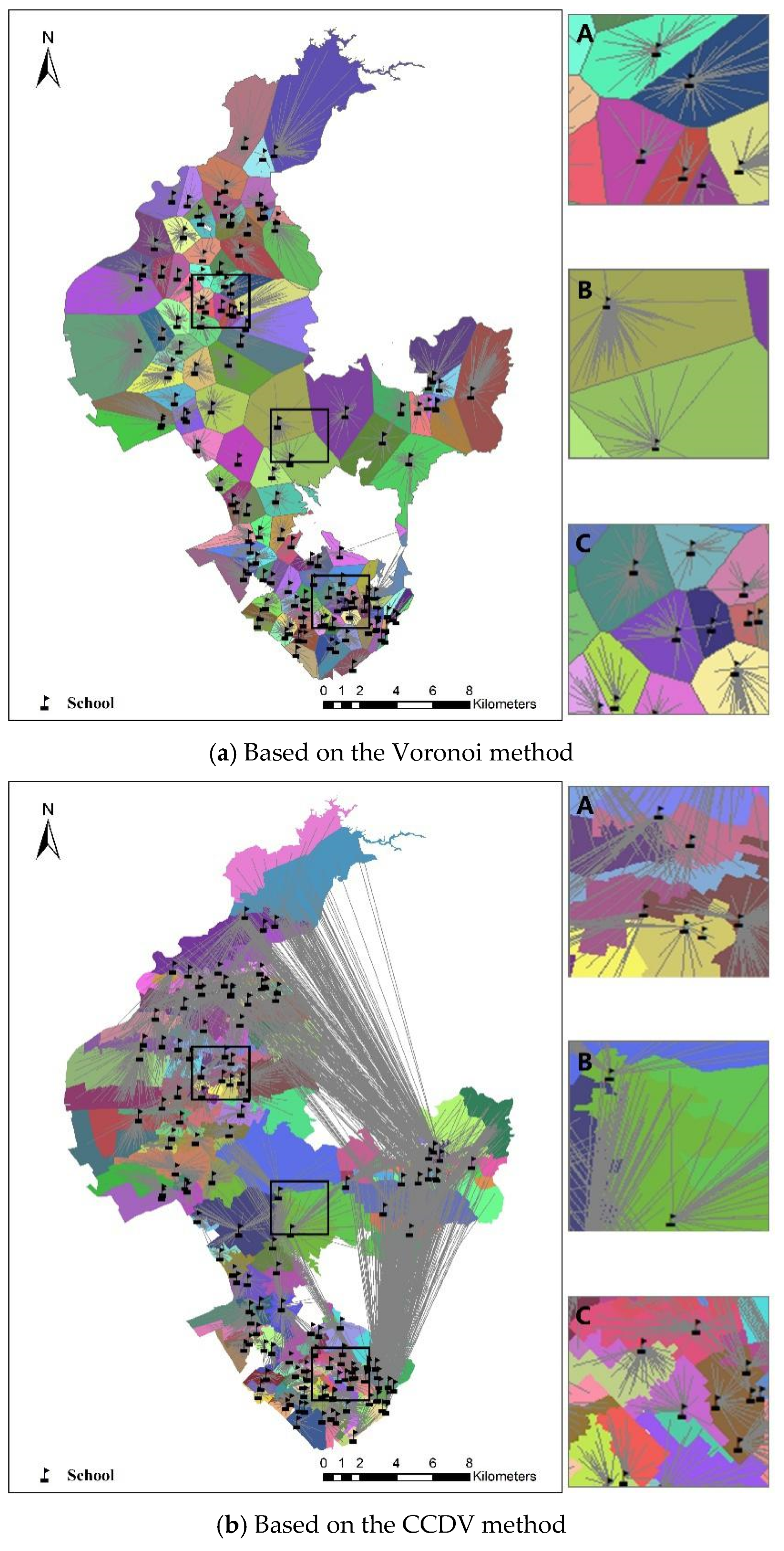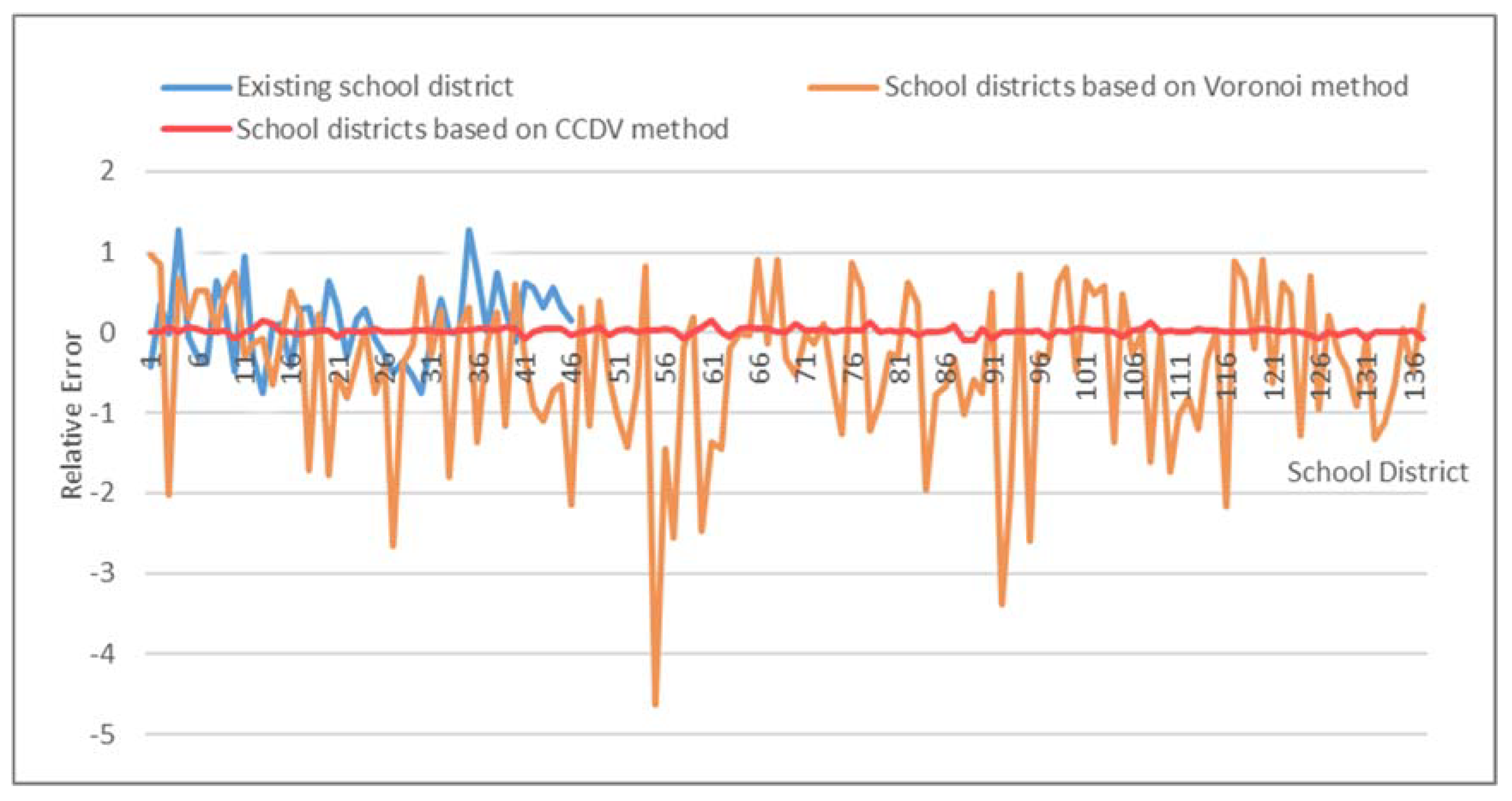Measuring the Service Capacity of Public Facilities Based on a Dynamic Voronoi Diagram
Abstract
1. Introduction
2. Dynamic Voronoi Method Based on Conditional Constraints (CCDV)
- (1)
- By taking the school’s spatial position as the reference point, use the Voronoi diagram algorithm to segment the plane where the school is located and ensure that the boundary of the generated Thiessen polygon can cover all areas with school-age students.
- (2)
- Calculate the center of gravity of each Thiessen polygon, and sort the centers of gravity from low to high in the order of longitude first and then latitude to form a fixed sequence of Thiessen polygons.
- (3)
- Select the first Thiessen polygon, assuming that the number of students in the school within the polygon is (i refers to a school). The total number of school-age children within the polygon is counted according to the community units covered by the polygon. First, calculate the center of gravity of each community, and sort the center of gravity from low to high in the order of longitude first and then latitude. Second, suppose that there are j community units in the range, and that the number of students represented by each unit is . Again, sequentially accumulate the number of school-age students in the area according to the order of the community’s center of gravity, that is, . Since it is generally impossible to guarantee that the number of students in a school zone is exactly equal to the school’s capacity, a floating range is set for the school’s capacity so that the number of students in each school zone will float within a certain range. Given the situation in Shenzhen, the school capacity range set in this article is . This parameter can be adjusted according to actual needs. If , then stop the iteration. M is the number of students assigned to the school, and all community units that participate in the iteration represent the area covered by the school district.
- (4)
- If all the community units in the polygon in the previous step cannot meet the stop condition after iterating, then this means that the number of students in the area is less than the number that the school can accommodate. Therefore, expand the search range. Setting too small a range will result in low search efficiency, and setting too large a range will cause the distance between students and the school to be too far, which is not conducive to the principle of nearby enrollment. To address this, the algorithm will gradually expand the search range to search for the optimal area. First, set an initial expansion range based on the original polygon boundary, which is 100 m in this article. Then, set a search step length, which in this article is 10 m, and the range will be gradually expanded on the basis of a 100 m range. When the total number of students in the search area is less than or equal to the number of students that the school can accommodate, the search stops. The polygon boundary is regarded as the new school district range.
- (5)
- Save the mapping relationship between the schools and community units that have been allocated. At the same time, remove the allocated schools and community units from the original data. Regenerate Thiessen polygons from the remaining school point data, and return to step (1) to start the next round of iterative calculations.
- (6)
- Since at least 3three points can form a Thiessen polygon, when iterating to the last two remaining schools, a polygon cannot be formed. Therefore, arbitrarily choose a school as the center, and follow the method in step (4) to expand the search range gradually. Stop the search when the total number of students in the search area is less than or equal to the number of students that the school can accommodate, and the polygon boundary is regarded as the new school district range. Since it is impossible to ensure that the number of people allocated each time is exactly equal to the school’s capacity, there may be a surplus of schools or students at the end of the allocation, that is, the supply of schools and the demand for schools of school-age students may be imbalanced. Therefore, in the calculation, it is necessary to determine whether the school and the students are all allocated. If the school is allocated, then the results of all school district divisions are output; if there are too many students, then the students who are not allocated to the school are marked, and the corresponding community is output.
3. School District Division Experiment and Analysis
3.1. Experimental Area and Data Description
3.2. Experimental Results
3.3. Result Verification
- (1)
- Accessibility
- (2)
- Supply and demand balance
4. Conclusions
Author Contributions
Funding
Data Availability Statement
Acknowledgments
Conflicts of Interest
References
- Setyono, D.; Cahyono, D.; Helmy, M. Measuring service capacity of public facilities based on supply aspect (Case study: Elementary school in Malang city). Procedia Soc. Behav. Sci. 2016, 227, 45–51. [Google Scholar] [CrossRef][Green Version]
- Jin, M.; Liu, L.; Tong, D.; Gong, Y.; Liu, Y. Evaluating the Spatial Accessibility and Distribution Balance of Multi-Level Medical Service Facilities. Int. J. Environ. Res. Public Health 2019, 16, 1150. [Google Scholar] [CrossRef]
- He, X.; Zhou, C.; Zhang, J.; Yuan, X. Using Wavelet Transforms to Fuse Nighttime Light Data and POI Big Data to Extract Urban Built-Up Areas. Remote Sens. 2020, 12, 3887. [Google Scholar] [CrossRef]
- Song, Z.; Chen, W.; Yuan, F.; Wang, L. Formulation of public facility location theory framework and literature review. Prog. Geogr. 2010, 29, 1499–1508. [Google Scholar]
- Zhang, J.; Ge, Z.; Luo, Z.; Sun, S. Research on equalized layout of urban and rural public facilities: A case study of educational facilities in Changzhou. City Plan. Rev. 2012, 36, 9–15. [Google Scholar]
- Mei, D.; Xiu, C.; Feng, X.; Wei, Y. Study of the School–Residence Spatial Relationship and the Characteristics of Travel-to-School Distance in Shenyang. Sustainability 2019, 11, 4432. [Google Scholar] [CrossRef]
- Li, J. A Positive Research on nearby enrollment at the stage of compulsory education. Res. Educ. Dev. 2007, 23, 39–43. [Google Scholar]
- Lu, N.; Huang, H. Examining the school choice phenomenon: Reflection on global context and local conditions. Res. Educ. Dev. 2009, 20, 1–6. [Google Scholar]
- Ernest, K. Mathematical analysis applied to school attendance areas. Socio Econ. Plan. Sci. 1968, 1, 465–475. [Google Scholar]
- Franklin, A.; Ernest, K. Computed school assignments in a large district. Oper. Res. 1973, 21, 413–426. [Google Scholar] [CrossRef]
- Heckmana, L.; Taylorb, H. School rezoning to achieve racial balance: A linear programming approach. Socio Econ. Plan. Sci. 1969, 3, 127–133. [Google Scholar] [CrossRef]
- Mckeown, P.; Workman, B. A study in using linear programming to assign students to schools. Interfaces 1976, 6, 96–101. [Google Scholar] [CrossRef]
- Taylor, R.; Vasu, M.; Causby, J. Intergrated planning for school and community: The case of Johnston county, North Carolina. Interfaces 1999, 29, 67–89. [Google Scholar] [CrossRef]
- Beheshtifar, S.; Alimoahmmadi, A. A multiobjective optimization approach for location-allocation of clinics. Int. Trans. Oper. Res. 2015, 22, 313–328. [Google Scholar] [CrossRef]
- He, Q. Study on Division of Primary School District in Beilin District, Xi’an City; Xian University of Architecture and Technology: Xi’an, China, 2018. [Google Scholar]
- Caro, F.; Shirabe, T.; Guignard, M.; Weintraub, A. School redistricting: Embedding GIS tools with integer programming. J. Oper. Res. Soc. 2004, 55, 836–849. [Google Scholar] [CrossRef]
- Novaes, A.G.N.; De Cursi, J.E.S.; Da Silva, A.C.L.; Souza, J.C. Solving continuous location-districting problems with Voronoi diagrams. Comput. Oper. Res. 2009, 36, 40–59. [Google Scholar] [CrossRef]
- Kong, Y. Optimal school allocation using GIS and linear programming. Geomat. Inf. Sci. Wuhan Univ. 2012, 37, 513–515. [Google Scholar]
- Tong, G.; Li, P.; Liu, Z.; Hu, Y. The GIS in Shenyang primary and secondary schools layout planning. Planners 2014, 30, 68–74. [Google Scholar]
- Chen, J.; Zhao, X.; Li, Z. An Algorithm for the Generation of Voronoi Diagrams on the Sphere Based on QTM. Photogramm. Eng. Rem. S. 2003, 69, 79–89. [Google Scholar] [CrossRef]
- Zhang, L.; Zhou, H. Research on Public Establishment Location Selection Based on the Voronoi Diagram in GIS. Comput. Eng. Appl. 2004, 40, 223–227. [Google Scholar]
- Okabe, A.; Satoh, T.; Furuta, T.; Suzuki, A.; Okano, K. Generalized network Voronoi diagrams: Concepts, computational methods, and applications. Int. J. Geogr. Inf. Sci. 2008, 22, 965–994. [Google Scholar] [CrossRef]
- Li, X.; Chen, J.; Zhao, L.; Guo, S.; Sun, L.; Zhao, X. Adaptive Distance-Weighted Voronoi Tessellation for Remote Sensing Image Segmentation. Remote Sens. 2020, 12, 4115. [Google Scholar] [CrossRef]
- Bong, C.; Wang, Y. A multiobjective hybrid metaheuristic approach for GIS-based spatial zoning model. J. Math. Model. Algorithms 2004, 3, 245–261. [Google Scholar]
- Kong, Y.; Zhu, Y.; Wang, Y. A hybrid metaheuristic algorithm for the school districting problem. Acta Geogr. Sin. 2017, 72, 256–268. [Google Scholar]
- Assad, A.; Deep, K. A hybrid harmony search and simulated annealing algorithm for continuous optimization. Inform. Sciences 2018, 450, 246–266. [Google Scholar]
- Luo, W.; Wang, F. Measures of Spatial Accessibility to Health Care in a GIS Environment: Synthesis and a Case Study in the Chicago Region. Environ. Plan. B Plan. Des. 2003, 30, 865–884. [Google Scholar] [CrossRef]
- Luo, W.; Qi, Y. An enhanced two-step floating catchment area (E2SFCA) method for measuring spatial accessibility to primary care physicians. Health Place 2009, 15, 1100–1107. [Google Scholar] [CrossRef]
- Mcgrail, M.; Humphreys, J. Measuring spatial accessibility to primary care in rural areas: Improving the effectiveness of the two-step floating catchment area method. Appl. Geogr. 2009, 29, 533–541. [Google Scholar] [CrossRef]
- Luo, W.; Whippo, T. Variable catchment sizes for the two-step floating catchment area (2SFCA) method. Health Place 2012, 18, 789–795. [Google Scholar] [CrossRef] [PubMed]
- Tao, Z.; Cheng, Y. Research progress of the two-step floating catchment area method and extensions. Prog. Geogr. 2016, 35, 589–599. [Google Scholar]
- Wan, N.; Zou, B.; Sternberg, T. A three-step floating catchment area method for analyzing spatial access to health services. Int. J. Geogr. Inf. Sci. 2012, 26, 1073–1089. [Google Scholar] [CrossRef]
- Mao, L.; Nekorchuk, D. Measuring spatial accessibility to healthcare for populations with multiple transportation modes. Health Place 2013, 24, 115–122. [Google Scholar] [CrossRef]
- Zhao, Y.; Zhang, G.; Lin, T.; Liu, X.; Liu, J.; Lin, M.; Ye, H.; Kong, L. Towards Sustainable Urban Communities: A Composite Spatial Accessibility Assessment for Residential Suitability Based on Network Big Data. Sustainability 2018, 10, 4767. [Google Scholar] [CrossRef]
- Chen, Y.; Gong, J.; Shi, W. Research on the optimal path algorithm in multi-level road network. Geomat. Inf. Sci. Wuhan Univ. 2006, 31, 70–73. [Google Scholar]
- Masouleh, F.; Murayama, Y.; Rho’Dess, T. The application of GIS in education administration: Protecting students from hazardous roads. Trans. GIS 2009, 13, 105–123. [Google Scholar] [CrossRef]
- Slagle, M. GIS in Community-Based School Planning: A Tool to Enhance Decision Making, Cooperation, and Democratization in the Planning Process; Cornell University: Ithaca, NY, USA, 2000. [Google Scholar]
- Okabe, A.; Okunuki, K. A computational method for estimating the demand of retail stores on a street network and its implementation in GIS. Trans. GIS 2001, 5, 209–220. [Google Scholar] [CrossRef]
- Hanley, P. Transportation cost changes with statewide school district consolidation. Socio Econ. Plan. Sci. 2007, 41, 163–179. [Google Scholar] [CrossRef]
- Liu, X. Research on Optimization of Primary School Planning Layout Based on Accessibility; Wuhan University: Wuhan, China, 2017. [Google Scholar]
- Kazemzadeh-Zow, A.; Shahraki, S.; Salvati, L.; Samani, N. A spatial zoning approach to calibrate and validate urban growth models. Int. J. Geogr. Inf. Sci. 2017, 31, 763–782. [Google Scholar] [CrossRef]
- Penchansky, R.; Thomas, J. The Concept of Access: Definition and Relationship to Consumer Satisfaction. Med. Care 1981, 19, 127–140. [Google Scholar] [CrossRef]
- Wang, D.; Xuan, W.; Ma, Y.; Wang, P. Study on optimal distribution of urban public service facilities based on supply-demand balance theory. J. Hefei Univ. Technol. 2019, 42, 848–855. [Google Scholar]






| Total Distance/km | Farthest Distance/km | Shortest Distance/km | Average Distance/km | |
|---|---|---|---|---|
| Existing school district | 7155.72 | 3.57 | 0.22 | 1.48 |
| School districts based on the Voronoi method | 5338.52 | 1.67 | 0.14 | 1.10 |
| School districts based on the CCDV method | 9825.24 | 16.63 | 0.19 | 2.03 |
Publisher’s Note: MDPI stays neutral with regard to jurisdictional claims in published maps and institutional affiliations. |
© 2021 by the authors. Licensee MDPI, Basel, Switzerland. This article is an open access article distributed under the terms and conditions of the Creative Commons Attribution (CC BY) license (http://creativecommons.org/licenses/by/4.0/).
Share and Cite
Cui, H.; Wu, L.; Hu, S.; Lu, R. Measuring the Service Capacity of Public Facilities Based on a Dynamic Voronoi Diagram. Remote Sens. 2021, 13, 1027. https://doi.org/10.3390/rs13051027
Cui H, Wu L, Hu S, Lu R. Measuring the Service Capacity of Public Facilities Based on a Dynamic Voronoi Diagram. Remote Sensing. 2021; 13(5):1027. https://doi.org/10.3390/rs13051027
Chicago/Turabian StyleCui, Haifu, Liang Wu, Sheng Hu, and Rujuan Lu. 2021. "Measuring the Service Capacity of Public Facilities Based on a Dynamic Voronoi Diagram" Remote Sensing 13, no. 5: 1027. https://doi.org/10.3390/rs13051027
APA StyleCui, H., Wu, L., Hu, S., & Lu, R. (2021). Measuring the Service Capacity of Public Facilities Based on a Dynamic Voronoi Diagram. Remote Sensing, 13(5), 1027. https://doi.org/10.3390/rs13051027








